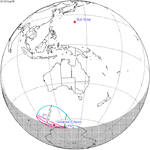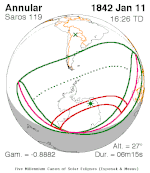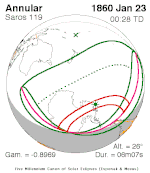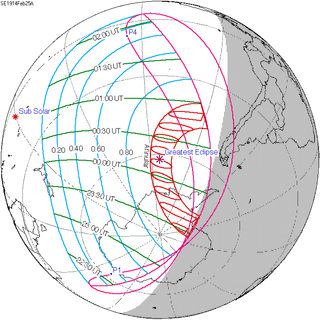Solar eclipse of February 25, 1914
| Solar eclipse of February 25, 1914 | |
|---|---|
| Type of eclipse | |
| Nature | Annular |
| Gamma | −0.9416 |
| Magnitude | 0.9248 |
| Maximum eclipse | |
| Duration | 335 s (5 min 35 s) |
| Coordinates | 62°06′S 113°18′W / 62.1°S 113.3°W |
| Max. width of band | 839 km (521 mi) |
| Times (UTC) | |
| Greatest eclipse | 0:13:01 |
| References | |
| Saros | 119 (60 of 71) |
| Catalog # (SE5000) | 9313 |
An annular solar eclipse occurred at the Moon's ascending node of orbit on Wednesday, February 25, 1914,[1][2] with a magnitude of 0.9248. A solar eclipse occurs when the Moon passes between Earth and the Sun, thereby totally or partly obscuring the image of the Sun for a viewer on Earth. An annular solar eclipse occurs when the Moon's apparent diameter is smaller than the Sun's, blocking most of the Sun's light and causing the Sun to look like an annulus (ring). An annular eclipse appears as a partial eclipse over a region of the Earth thousands of kilometres wide.
It took place almost entirely over the Southern Ocean, near Antarctica;[1] at its widest, the shadow cast by the moon was 167 mi (269 km) wide.[1] As a result, it could be seen from small patches of land, most notably southern Patagonia and part of New Zealand.[1][2][3] Due to this limited visibility, the Star-Gazette of Elmira said that for readers in the United States it was "not particularly interesting from a popular perspective";[4] the Salina Daily Union in Salina, Kansas said that "you perhaps didn't notice it".[5] It was the first of four eclipses that occurred during the year 1914.[2][3] While its path passed over New Zealand, and some attempted to view it in Wellington, it was reported to not have been visible there due to cloud cover.[6][7]
Related eclipses[edit]
Eclipses in 1914[edit]
- An annular solar eclipse on February 25, 1914.
- A partial solar eclipse on March 12, 1914.
- A total solar eclipse on August 21, 1914.
- A partial lunar eclipse on September 4, 1914.
Metonic[edit]
- Preceded by: Solar eclipse of May 9, 1910
- Followed by: Solar eclipse of December 14, 1917
Tzolkinex[edit]
- Preceded by: Solar eclipse of January 14, 1907
- Followed by: Solar eclipse of April 8, 1921
Half-Saros[edit]
- Preceded by: Lunar eclipse of February 19, 1905
- Followed by: Lunar eclipse of March 3, 1923
Tritos[edit]
- Preceded by: Solar eclipse of March 29, 1903
- Followed by: Solar eclipse of January 24, 1925
Solar Saros 119[edit]
- Preceded by: Solar eclipse of February 13, 1896
- Followed by: Solar eclipse of March 7, 1932
Inex[edit]
- Preceded by: Solar eclipse of March 16, 1885
- Followed by: Solar eclipse of February 4, 1943
Triad[edit]
- Preceded by: Solar eclipse of April 26, 1827
- Followed by: Solar eclipse of December 25, 2000
Solar eclipses of 1913–1917[edit]
This eclipse is a member of a semester series. An eclipse in a semester series of solar eclipses repeats approximately every 177 days and 4 hours (a semester) at alternating nodes of the Moon's orbit.[8]
The partial solar eclipses on April 6, 1913 and September 30, 1913 occur in the previous lunar year eclipse set, and the solar eclipses on December 24, 1916 (partial), June 19, 1917 (partial), and December 14, 1917 (annular) occur in the next lunar year eclipse set.
| Solar eclipse series sets from 1913 to 1917 | ||||||
|---|---|---|---|---|---|---|
| Descending node | Ascending node | |||||
| Saros | Map | Gamma | Saros | Map | Gamma | |
| 114 | August 31, 1913 Partial |
1.4512 | 119 | February 25, 1914 Annular |
−0.9416 | |
| 124 | August 21, 1914 Total |
0.7655 | 129 | February 14, 1915 Annular |
−0.2024 | |
| 134 | August 10, 1915 Annular |
0.0124 | 139
|
February 3, 1916 Total |
0.4987 | |
| 144 | July 30, 1916 Annular |
−0.7709 | 149 | January 23, 1917 Partial |
1.1508 | |
| 154 | July 19, 1917 Partial |
−1.5101 | ||||
Saros 119[edit]
This eclipse is a part of Saros series 119, repeating every 18 years, 11 days, and containing 71 events. The series started with a partial solar eclipse on May 15, 850 AD. It contains total eclipses on August 9, 994 AD and August 20, 1012; a hybrid eclipse on August 31, 1030; and annular eclipses from September 10, 1048 through March 18, 1950. The series ends at member 71 as a partial eclipse on June 24, 2112. Its eclipses are tabulated in three columns; every third eclipse in the same column is one exeligmos apart, so they all cast shadows over approximately the same parts of the Earth.
The longest duration of totality was produced by member 10 at 32 seconds on August 20, 1012, and the longest duration of annularity was produced by member 44 at 7 minutes, 37 seconds on September 1, 1625. All eclipses in this series occur at the Moon’s ascending node of orbit.[9]
| Series members 54–71 occur between 1801 and 2112: | ||
|---|---|---|
| 54 | 55 | 56 |
 December 21, 1805 |
 January 1, 1824 |
 January 11, 1842 |
| 57 | 58 | 59 |
 January 23, 1860 |
 February 2, 1878 |
 February 13, 1896 |
| 60 | 61 | 62 |
 February 25, 1914 |
 March 7, 1932 |
 March 18, 1950 |
| 63 | 64 | 65 |
 March 28, 1968 |
 April 9, 1986 |
 April 19, 2004 |
| 66 | 67 | 68 |
 April 30, 2022 |
 May 11, 2040 |
 May 22, 2058 |
| 69 | 70 | 71 |
 June 1, 2076 |
 June 13, 2094 |
 June 24, 2112 |
Tritos series[edit]
This eclipse is a part of a tritos cycle, repeating at alternating nodes every 135 synodic months (≈ 3986.63 days, or 11 years minus 1 month). Their appearance and longitude are irregular due to a lack of synchronization with the anomalistic month (period of perigee), but groupings of 3 tritos cycles (≈ 33 years minus 3 months) come close (≈ 434.044 anomalistic months), so eclipses are similar in these groupings.
| Series members between 1901 and 2100 | |||
|---|---|---|---|
 March 29, 1903 (Saros 118) |
 February 25, 1914 (Saros 119) |
 January 24, 1925 (Saros 120) | |
 December 25, 1935 (Saros 121) |
 November 23, 1946 (Saros 122) |
 October 23, 1957 (Saros 123) | |
 September 22, 1968 (Saros 124) |
 August 22, 1979 (Saros 125) |
 July 22, 1990 (Saros 126) | |
 June 21, 2001 (Saros 127) |
 May 20, 2012 (Saros 128) |
 April 20, 2023 (Saros 129) | |
 March 20, 2034 (Saros 130) |
 February 16, 2045 (Saros 131) |
 January 16, 2056 (Saros 132) | |
 December 17, 2066 (Saros 133) |
 November 15, 2077 (Saros 134) |
 October 14, 2088 (Saros 135) | |
 September 14, 2099 (Saros 136) |
|||
Metonic series[edit]
The metonic series repeats eclipses every 19 years (6939.69 days), lasting about 5 cycles. Eclipses occur in nearly the same calendar date. In addition, the octon subseries repeats 1/5 of that or every 3.8 years (1387.94 days).
| 22 eclipse events between December 13, 1898 and July 20, 1982 | ||||
|---|---|---|---|---|
| December 13–14 | October 1–2 | July 20–21 | May 9 | February 24–25 |
| 111 | 113 | 115 | 117 | 119 |
 December 13, 1898 |
 July 21, 1906 |
 May 9, 1910 |
 February 25, 1914 | |
| 121 | 123 | 125 | 127 | 129 |
 December 14, 1917 |
 October 1, 1921 |
 July 20, 1925 |
 May 9, 1929 |
 February 24, 1933 |
| 131 | 133 | 135 | 137 | 139 |
 December 13, 1936 |
 October 1, 1940 |
 July 20, 1944 |
 May 9, 1948 |
 February 25, 1952 |
| 141 | 143 | 145 | 147 | 149 |
 December 14, 1955 |
 October 2, 1959 |
 July 20, 1963 |
 May 9, 1967 |
 February 25, 1971 |
| 151 | 153 | 155 | ||
 December 13, 1974 |
 October 2, 1978 |
 July 20, 1982 | ||
References[edit]
- ^ a b c d "ECLIPSES OF 1914". The Washington Herald. Washington, District of Columbia. 1914-02-26. p. 4. Retrieved 2023-11-11 – via Newspapers.com.
- ^ a b c "AN ECLIPSE OF SUN TOMORROW". The Butte Daily Post. Butte, Montana. 1914-02-23. p. 12. Retrieved 2023-11-11 – via Newspapers.com.
- ^ a b "Down in Patagonia and the Southeastern Coast of New Zealant Annular Eclipse of the Sun Is Visible". The Missoula Sentinel. Missoula, Montana. 1914-02-25. p. 6. Retrieved 2023-11-11 – via Newspapers.com.
- ^ "Moon Eclipses Sun Is Not Visible Here". Star-Gazette. Elmira, New York. 1914-02-23. p. 2. Retrieved 2023-11-11 – via Newspapers.com.
- ^ "ECLIPSE OF THE SUN". The Salina Daily Union. Salina, Kansas. 1914-02-25. p. 1. Retrieved 2023-11-11 – via Newspapers.com.
- ^ "ECLIPSE OF THE SUN". The Sydney Morning Herald. Sydney, New South Wales, New South Wales, Australia. 1914-02-26. p. 9. Retrieved 2023-11-11 – via Newspapers.com.
- ^ "Clouds obscure eclipse". The Daily Telegraph. Sydney, New South Wales, Australia. 1914-02-26. p. 9. Retrieved 2023-11-11 – via Newspapers.com.
- ^ van Gent, R.H. "Solar- and Lunar-Eclipse Predictions from Antiquity to the Present". A Catalogue of Eclipse Cycles. Utrecht University. Retrieved 6 October 2018.
- ^ "NASA - Catalog of Solar Eclipses of Saros 119". eclipse.gsfc.nasa.gov.
- Earth visibility chart and eclipse statistics Eclipse Predictions by Fred Espenak, NASA/GSFC




